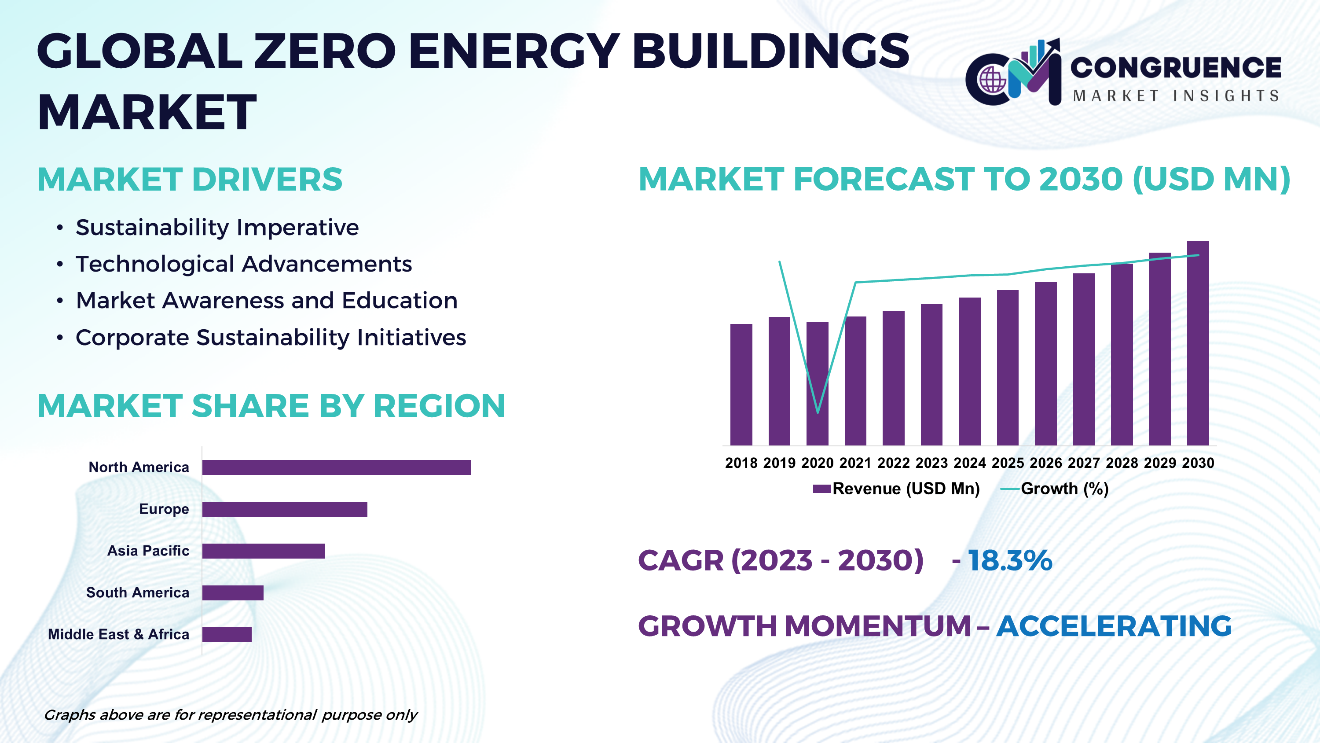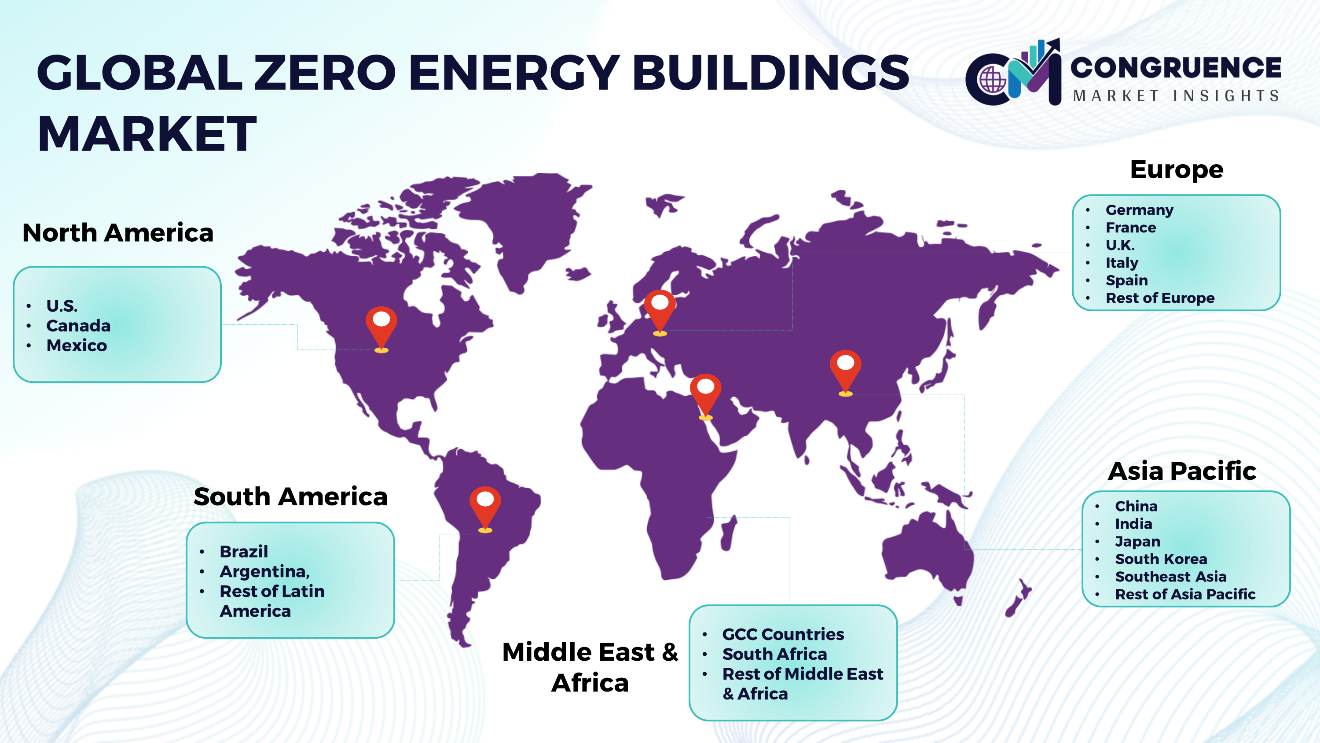Reports
The Global Zero Energy Buildings Market is expected to expand at a CAGR of 18.3% between 2023 and 2030. Zero Energy Buildings (ZEBs) herald a new era in sustainable construction, aiming to achieve net-zero energy consumption over time. Their emergence signifies a transformative shift within the construction sector, blending forward-thinking design principles with state-of-the-art technology. ZEBs employ an array of sophisticated technologies for energy generation, storage, and management, such as solar panels, energy-efficient HVAC systems, smart meters, and building automation systems. These components operate synergistically to optimize energy utilization and minimize waste, culminating in the realization of net-zero energy goals. Integration with Information Technology (IT) infrastructure enables real-time monitoring, control, and optimization of energy flows within the building. Despite initial cost considerations, the rising emphasis on sustainability and energy efficiency drives the market landscape of ZEBs, with increasing investments and regulatory backing fostering their adoption globally.

Zero Energy Buildings Market Major Driving Forces
Sustainability Imperative: The escalating global concern regarding environmental degradation and climate change mandates a concerted effort towards sustainable practices, compelling stakeholders across sectors to prioritize Zero Energy Buildings (ZEBs) as a pivotal solution for reducing carbon emissions and mitigating environmental impact.
Technological Advancements: Continuous advancements in renewable energy, energy storage, building automation, and smart grid technologies are pivotal in enhancing the feasibility and efficacy of ZEBs. These technological innovations contribute to improving the performance and accessibility of ZEB solutions, driving market growth.
Market Awareness and Education: Efforts to disseminate knowledge about the advantages of ZEBs, coupled with educational initiatives and demonstration projects, play a pivotal role in raising awareness and fostering consumer confidence in adopting these cutting-edge building practices.
Corporate Sustainability Initiatives: Many corporations prioritize sustainability as an integral component of their corporate social responsibility (CSR) initiatives. Consequently, there is a heightened demand for ZEBs in commercial and institutional sectors, driven by corporate commitments to environmental stewardship and sustainable business practices.
Zero Energy Buildings Market Key Opportunities
Ongoing Advancements and Increasing Focus on Research: Ongoing developments in renewable energy, energy storage, and building automation technologies represent a significant avenue of growth for the Zero Energy Buildings (ZEBs) market. Progress in solar panels, wind turbines, and energy storage systems contributes to heightened energy efficiency and management capabilities within ZEBs. Furthermore, innovations in building automation and control systems facilitate enhanced monitoring and optimization of energy utilization, thereby aiding ZEBs in achieving their energy-neutral objectives more proficiently.
Integration of Design Methodologies: Embracing integrated design methodologies stands as a crucial imperative for maximizing the efficacy of Zero Energy Buildings (ZEBs). This approach entails the early incorporation of energy efficiency and sustainability considerations into the architectural, mechanical, and electrical aspects of building design and construction. By amalgamating architectural features with passive design strategies, such as proper orientation, insulation, and natural ventilation, ZEBs can optimize energy performance while minimizing reliance on additional renewable energy sources.
Resilience and Adaptation Strategies: Zero Energy Buildings (ZEBs) offer a distinctive opportunity to address resilience and adaptation challenges posed by climate change in the built environment. Through the incorporation of resilient design elements, such as robust building envelopes, backup power systems, and passive heating and cooling techniques, ZEBs can better withstand adverse weather conditions and other environmental stressors. Furthermore, ZEBs contribute to adaptation efforts by curbing greenhouse gas emissions and alleviating the impacts of climate change on the built landscape.
Zero Energy Buildings Market Key Trends
· Increasing adoption of rigorous certification standards like LEED Zero and Passive House Plus validates energy performance and sustainability claims of Zero Energy Buildings (ZEBs).
· The emergence of buildings capable of producing more energy than they consume reflects a shift towards proactive energy generation and highlights the feasibility of achieving energy surplus.
· Leveraging Internet of Things (IoT) technology and advanced building automation systems optimizes energy usage, enhances occupant comfort, and improves operational efficiency in ZEBs.
· Prefabricated and modular construction techniques streamline ZEB development, reducing construction time, costs, and environmental impact while maintaining high-quality standards.
· Phasing out fossil fuel-based heating and cooling systems in favor of electric alternatives aligns with ZEB goals, promoting energy efficiency and carbon neutrality.
· Retrofitting existing buildings to achieve Zero Energy status offers a sustainable solution to upgrade outdated infrastructure, reduce energy consumption, and extend the lifespan of built assets.
· Growing interest in Zero Energy Communities fosters collaborative efforts among developers, municipalities, and stakeholders to create sustainable, self-sufficient neighborhoods with interconnected ZEBs.
· Consideration of life-cycle assessment and embodied carbon reduction strategies ensures holistic sustainability in ZEB projects, encompassing the environmental impact of materials, construction, and operation.

Market Competition Landscape
The market competition landscape in the zero energy buildings sector is characterized by intense rivalry driven by innovation and sustainability. Key factors influencing competition include technological advancements, regulatory compliance, pricing strategies, and market positioning. Companies vie for market share by offering differentiated solutions, emphasizing energy efficiency, and adhering to industry standards. Customer satisfaction, brand reputation, and strategic partnerships also play crucial roles in shaping competitive dynamics.
Key players in the global Zero Energy Buildings market implement various organic and inorganic strategies to strengthen and improve their market positioning. Prominent players in the market include:
· Siemens
· Johnson Controls
· Tesla Outsourcing Services
· Schneider Electric
· Honeywell International Inc.
· Saint-Gobain
· Panasonic Corporation
· CBRE
· Trane
· Lutron Electronics Co., Inc.
· ABB
· LEGRAND SA
· Nexans
· Bosch Sicherheitssysteme GmbH
· Kingspan Group
|
Report Attribute/Metric |
Details |
|
Base Year |
2022 |
|
Forecast Period |
2023 – 2030 |
|
Historical Data |
2018 to 2022 |
|
Forecast Unit |
Value (US$ Mn) |
|
Key Report Deliverable |
Revenue Forecast, Growth Trends, Market Dynamics, Segmental Overview, Regional and Country-wise Analysis, Competition Landscape |
|
Segments Covered |
· By Component (Windows and Doors, HVAC Systems, Lighting Systems, Renewable Energy Systems, Building Energy Management Systems (BEMS), and Others) · By Technology (Solar Photovoltaic (PV), Wind Energy, Geothermal Energy, Biomass, and Others) · By Application (New Construction, and Renovations) · By End-Use (Residential, Commercial, Institutional and Industrial) |
|
Geographies Covered |
North America: U.S., Canada and Mexico Europe: Germany, France, U.K., Italy, Spain, and Rest of Europe Asia Pacific: China, India, Japan, South Korea, Southeast Asia, and Rest of Asia Pacific South America: Brazil, Argentina, and Rest of Latin America Middle East & Africa: GCC Countries, South Africa, and Rest of Middle East & Africa |
|
Key Players Analyzed |
Siemens, Johnson Controls, Tesla Outsourcing Services, Schneider Electric, Honeywell International Inc., Saint-Gobain, Panasonic Corporation, CBRE, Trane, Lutron Electronics Co., Inc., ABB, LEGRAND SA, Nexans, Bosch Sicherheitssysteme GmbH, Kingspan Group |
|
Customization & Pricing |
Available on Request (10% Customization is Free) |
